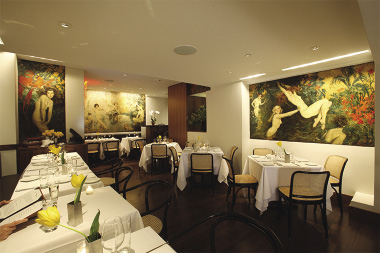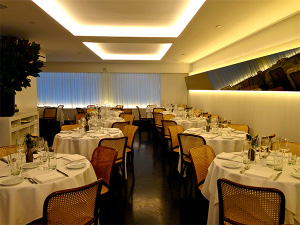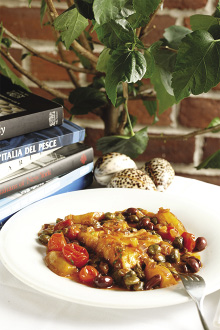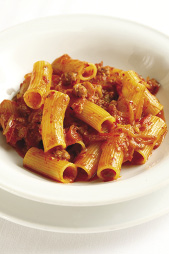


![]()
ONLINE

Authentic Traditional Italian Cuisine
Editors’ Note
Originally from Naples, Italy, Gianfranco Sorrentino carries over 30 years of experience in restaurant management at properties including Quisitana Hotel in Capri, Dorchester Hotel in London, Four Seasons Hotel in Tokyo, Bice Restaurant in New York, Sette MoMA Restaurant at The Museum of Modern Art of New York, Union Bar and Grill in Great Barrington, Massachusetts, and The Leopard at des Artistes in the New York landmark the Hotel des Artistes. In September 2001, he opened Il Gattopardo, just across the street from MoMA, along with his wife Paula Bolla and his talented Executive Chef Vito Gnazzo.
Company Brief
Il Gattopardo (www.ilgattopardonyc.com) serves traditional Southern Italian comfort food that has been adapted for the contemporary palate without compromising the authenticity of the cuisine. Il Gattopardo is committed to producing top quality Southern Italian gastronomy, to using authentic ingredients, and to keeping the tradition of Italian culture and hospitality vibrant and passionate. After 12 years at its original location, the restaurant has a new home at The Rockefeller Townhouses.
The Leopard at des Artistes (www.theleopardnyc.com), Il Gattopardo’s youngest sibling, is located in one of the most iconic spaces in New York City, the Hotel des Artistes. The Leopard finds its roots in the area once known as “The Kingdom of the Two Sicilies” and in the culinary traditions of the regions of Campania, Basilicata, Calabria, Apulia, Sardinia, and Sicily. The dishes are a balance of rural elements from these regions and include pasta, vegetables, cheese, and seafood ingredients from the Costiera.
What was the thinking behind moving Il Gattopardo to a new location, and how has that been received?
We opened Il Gattopardo on September 18, 2001 – one week after the Twin Towers tragedy.
We already had a restaurant in the Museum of Modern Art across the street and the museum was going through a big renovation, so we were looking for a restaurant in the area.
Despite the tragedy, everyone still wanted to open.
We started with clientele who were coming from MoMA and slowly, the restaurant started to do better.

The Leopard at des Artistes
Every year since, we have done better than the year before, even in 2008 and 2009.
We moved the restaurant to The Rockefeller Townhouses because we love the building. Being at MoMA for 10 years, we have a passion for art and we deal with people in the art world. We opened The Leopard at des Artistes and the former Café des Artistes with beautiful murals from 1922 that we restored.
Once we saw our new location, which is the former Rockefeller residence, we fell in love. We have been behind this restaurant for many years.
We also have the room downstairs, which we use only for catering. We still have a lot of requests for catering from MoMA, but we also work a lot with Italian institutions, like the Italian Chamber of Commerce; the Italian Consulate; the Italian Cultural Institute; and big designers like Cucinelli.
You also have beautiful outdoor space?
Yes, the atrium, which we use for catering – not à la carte. We still believe in the restaurant with 70 to 80 seats, where you really can cook; once you have over 120 seats, the menu is dictated by the seats – everything has to be prepared before and assembled. We don’t want to do that.

Il Gattopardo
Is there a consistent feeling between Il Gattopardo and The Leopard?
Very much. The concept is the same. We believe in authentic traditional Italian cuisine, which is a cuisine of ingredients.
We carefully choose each ingredient we use; most of them are from Italy. We have a distributor that imports these products, some only for us from Italy. We are very proud of that.
At Il Gattopardo, we lean towards the regional cuisine of Campania. My chef is from Salerno and I’m from Napoli, so when we think about the menu, we remember what my and his grandmothers used to cook. Sometimes we fight, because you move two miles in Italy and the dish is different. But that is the fun of it.
At The Leopard, we did something more complex. The Leopard is the symbol of the South of Italy: Sicily. The cuisine is inclusive of Campania, Basilicata, Calabria, Apulia, Sardinia, and Sicily. So it’s a step back in tradition to the original recipes but with the modern eye so we choose the right ingredients and make it lighter.

Codfish in casseruola
Do you make your food with a health focus?
If the ingredients are well done, it’s not too much; if it’s done as it used to be, it’s good.
We pay a lot of attention to that. We don’t buy ingredients that are too industrial; we try always to find the artisanal.
How do you maintain a traditional menu while keeping it current?
It’s a challenge because we change it twice a year; we put new dishes on and someone always misses what we had, which we make if we can, but it’s important to keep abreast of what is going on in Italy and the world, as well as to educate our staff who then educate our customers about the ingredients and why we choose them and where they’re from.
Are your wines mainly from Italy?
We have 160 different labels on our wine list – all Italian. They are mainly from small artisanal wineries that we choose because we know them. They have a history – we know what they want to say and do with their wine. We know about their culture.
What helps a restaurant stand the test of time?
It takes caring about the details. The food has to be consistently good, we have to choose the right ingredients; I can teach the service but it’s the hospitality – how much you care about the customer. I tell the guys, you have to smile with your heart, not with your brain.

Rigatoni with a very spicy
anduja sausage
What do you look for when you hire?
Personality and attitude; if this person has positive energy. We train staff with three days of orientation, when we overload them with work. I want to see how they react: Do they take it or is it too much?
We can give all the training we want, but if they aren’t willing to do it, they never will.
Happy pickers make happy wine. Happy waiters make a happy restaurant.
Did you know early on that this was what you wanted to do?
Not really. But I started in this business as a child.
At 17, I moved to London in the summer and worked in several hotels. After a while, I realized that I was the one cooking at home; with friends, I was the one organizing the parties.
So I came naturally to this business. It’s like the theater – every night is a live show. And you cannot make a mistake. You have to be at the top every night.•